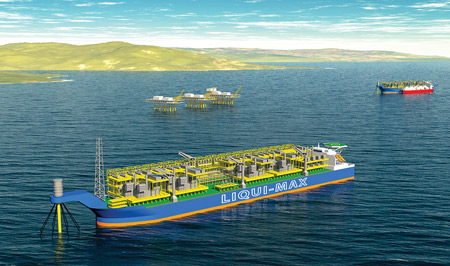Gas Processing News
A. Blume, Editor
Cogent Midstream to connect gas complex to GCX Pipeline
Cogent Midstream LLC will construct an approximately 25-mi pipeline to deliver residue gas from its Big Lake natural gas processing complex, located in Reagan County in the Midland Basin of West Texas, to Kinder Morgan’s Gulf Coast Express Pipeline (GCX Pipeline).
In addition to the GCX Pipeline, Cogent’s residue pipeline is expected to cross the proposed Permian Highway Pipeline and Whistler Pipeline projects. Cogent’s 20-in. pipeline is anticipated to come into service in 4Q 2019 and have a total capacity of approximately 400 MMft3d.
The pipeline’s in-service date coincides with Cogent’s 4Q timeline for commissioning its Big Lake II natural gas cryogenic processing plant. Presently under construction, the Big Lake II plant has the nameplate capacity to process 200 MMft3d of gas and will bring Cogent’s total processing capacity to approximately 510 MMft3d.
Australia’s NSW approves Port Kembla LNG import terminal
Australia’s New South Wales state has approved plans by a Japanese-backed consortium to build a A$250-MM ($176-MM) LNG import terminal at Port Kembla, looking to cut gas prices and avert a supply shortage.
The Port Kembla project is the first of five proposed LNG import terminals in Australia to receive planning approval. The projects should help plug a looming supply shortage expected in the country’s southeast in the 2020s.
Australian Industrial Energy (AIE), the JV planning to build the berth for a floating LNG import facility at Port Kembla, about 100 km (60 mi) south of Sydney, said the approval means it can now focus on lining up gas customers.
AIE aims to make a final investment decision around the middle of this year. The AIE joint venture partners are Squadron Energy, JERA Co. and Marubeni Corp. If the partners decide to go ahead with the project in the middle of this year, first gas could be delivered by late 2020, the partners said in a joint release.
Air Liquide E&C, Samsung partner for methanol plant
Air Liquide Engineering & Construction has entered into a partnership with Samsung Engineering for a front-end engineering and design (FEED) study of a methanol production plant for Sarawak Petchem, a state-owned oil and gas firm in Malaysia.
The FEED study is a key step that will help decision-makers obtain the necessary information to convert the contract into an engineering, procurement and construction (EPC) contract in the future. Air Liquide Engineering & Construction will be the technology licensor, while Samsung Engineering will design the project’s utility systems and balance of plant.
The methanol plant, which will be located in Bintulu, Sarawak, eastern Malaysia, will come into operation in 2023. The facility will produce 5,000 tpd of methanol based on Air Liquide Engineering & Construction proprietary process technology, Lurgi MegaMethanol™, which converts natural gas into methanol.
Global LNG Services launches FLNG in China
 |
Following a 6-yr concept development and verification program with support from leading players in the LNG field, Global LNG Services has announced the technical and commercial viability of a liquefaction cost, safety and environmental quality solution to accelerate the development of stranded gas.
The standardized, floating liquefaction solution—the LIQUI-MAX™ Vessel (LMV)—enables faster, lower-cost, “plug-and-play” development of LNG export facilities. Global LNG Services said it is particularly pleased that its LMV solution will be able to support China’s Blue Sky Action Plan to replace coal with gas and renewables on a scale large enough to save an estimated 1 MM lives from air pollution deaths and reduce CO2 emissions by 1 Btpy by 2030.
Global LNG Services has also made significant progress on its wholly owned Main Pass Energy Hub (MPEH) LNG export project in the Gulf of Mexico, which will eventually export as much as 48 MMtpy of LNG. A leading LNG EPC contractor has been selected as the exclusive EPCIC for the first 12-MMtpy LMV, for which Global LNG Services expects to reach a final investment decision by early 2021.
In June 2018, Global LNG Services and Baker Hughes, a GE Company, announced the selection of the LM9000 gas turbine, which enables large-scale liquefaction when combined with Air Products’ C1 methane-based refrigeration technology. The MPEH will become the highest-capacity and lowest-unit-cost floating liquefaction facility in the world.
The MPEH project has fundamental advantages not found in other LNG export facilities. A well-defined and previously permitted project site located 16 mi offshore the east coast of Louisiana, along with a development plan that utilizes the LMV, places GLS in a highly competitive position. The Deepwater Port of MPEH enables larger-scale, lower-risk and lower-cost logistics than any existing project in the Gulf of Mexico.
Negotiations with Asian offtakers for the anchor position in the MPEH project center on a tolling fee that includes an industry-lowest “anchor deal” of $1.50/MMBtu for part of the 12 MMtpy.
Atlas Copco to provide compressor technology for LNG carriers
 |
Drawing from its experience serving the LNG market, turbomachinery manufacturer Atlas Copco Gas and Process Division has secured a compressor order for the carrier LNG market. The order, placed by Samsung Heavy Industries in Korea, is for a total of eight HD centrifugal gas compressors and eight oil-free gas screw compressors, along with the necessary heaters and vaporizers. The equipment will be used on four 180,000-m3 vessels commissioned by Celsius Tankers. The first units will begin shipping from Atlas Copco Gas and Process to the customer beginning October 2019, with the remainder of the machinery to be delivered in 2Q 2020.
The new vessels will utilize Atlas Copco’s oil-free gas screw compressors to feed their XDF engines—a first in the carrier LNG industry. The new compressor technology was specifically designed to meet modern carrier needs, including the XDF pressure requirements and reduced flow of boiloff gas from improved insulation measures. The oil-free design also allows for significantly longer maintenance intervals compared to oil-flooded compressors, and can be used with a reliquefaction system without any risk of oil contamination in heat exchangers or LNG cargo.




Comments